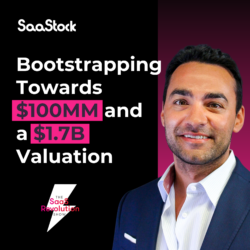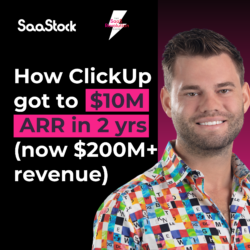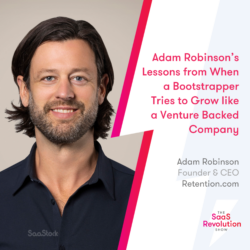The room is tense. A founder scrolls through dashboards late at night, obsessing over user numbers, retention curves, and what’s happening on Product Hunt. Across the table (or halfway across the world, on Slack), a marketer sharpens the copy for tomorrow’s email sequence, arguing with the founder about whether the call to action should be “Try Free” or “See Pricing.” Both want growth. Both are tired. Both are certain they know the secret sauce.
Welcome to the age-old tug-of-war in SaaS: Who should really own growth? Is it the founder, whose vision sparked the product in the first place? Or is it the marketer, trained in the dark arts of distribution, demand generation, and building brand affinity?
It’s not just a question for inside-the-room ego jousting. The answer shapes everything: how fast a SaaS startup can scale, what gets prioritized, and, often, who survives long enough to see real success. Growth is the difference between becoming the next big SaaS exit and quietly fading into the churn pile.
So let’s get honest—who should own growth in a SaaS startup? Why is the answer almost never as simple as “pick one,” and what does a winning approach actually look like when the stakes are real, the runway is shrinking, and there are no shortcuts left?
What “owning growth” actually means
Before the debate starts, let’s get definitions straight. “Growth” in SaaS is a loaded word. It isn’t just about “more users.” Growth is sustainable, compounding progress across acquisition, retention, expansion, and, ultimately, revenue. The playbook might look different at each stage (from finding product-market fit to blitzscaling to IPO), but the fundamentals are the same: attract, convert, keep, and expand users who love your product.
“Owning growth” means driving that playbook—setting the strategy, picking the tactics, owning the metrics, and taking responsibility when things stall. It’s accountability. It’s focus. It’s about who sweats the daily details, not just who drops in to review the dashboard.
Why founders think they should own growth (and sometimes must)
Founders are, by default, the engine of early-stage SaaS growth. They have the vision. They know the pain point better than anyone. In many cases, the first customers buy the founder, not just the software. This is especially relevant for a mobile app development company building products in their product development departments, where the founder’s insight into user needs is critical.
Why do founders feel this responsibility so keenly?
- No one knows the product like they do. The founder can demo features in their sleep. They’ve seen all the weird use cases, have battle scars from building the MVP, and understand the original “why” in a way that’s hard to teach.
- Credibility with early adopters. Early SaaS customers—especially in technical or enterprise categories—respond to founder-led pitches. It signals commitment and authority. Sometimes, getting that first big logo is a pure founder hustle.
- Resource constraints. Early on, there’s no budget for a full-stack growth team. “Everyone is in sales,” as the saying goes. Founders run onboarding calls, answer support tickets, write the first blog posts, and tweak onboarding emails between investor meetings.
- Fear of dilution. Growth is make-or-break. Delegating too soon feels like risking the company’s future on someone who might not “get it.” Many founders are scarred from stories of marketers who blew budgets or misunderstood the core problem.
And—if we’re being blunt—there’s ego. Founders want to believe they can do it all, at least until they can’t.
Why marketers are built for the growth game
Marketers are wired to make products move. They’re trained in story, channels, data, and experimentation. The best SaaS marketers are both artists and scientists, balancing narrative with numbers.
Here’s what they bring to the growth table:
- Deep expertise in distribution. Marketers know where the audience hangs out, what content grabs attention, and how to get a message from “unknown” to “must try.” They understand paid, organic, influencer, partnerships, and the subtle nuances of channel fit. Tools like ReferralCandy can be game changers here, enabling marketers to harness referral programs that scale user acquisition with clear incentives and measurable results.
- Experimentation muscle. Marketers thrive on “test, learn, optimize, repeat.” A good marketer will have five ideas running at any given moment, kill four, and double down on what’s working—without falling in love with their own ideas.
- Data discipline. They can spot the difference between vanity metrics and the numbers that actually drive revenue. Attribution, cohort analysis, funnel drop-offs—they live in the weeds and know which metrics are red herrings.
- Messaging craft. Good marketers translate complex features into stories that resonate. They make the product less about “what it does” and more about “why it matters”—a critical bridge for scaling beyond founder-led sales.
- Objectivity. Marketers bring a fresh, user-centric perspective. They see what customers care about, not just what founders wish they did.
When founders must lead growth (and when it goes wrong)
There’s a window where founder-led growth isn’t just smart—it’s non-negotiable. Pre-product-market fit (PMF), every “growth hack” is noise unless the product is solving a burning pain. Founders need to be in the trenches, talking to users, absorbing feedback, and tweaking the offer on the fly.
Classic signs it’s still a founder’s game:
- You’re selling vision as much as product.
- The ICP (ideal customer profile) is still shifting week to week.
- Your conversion funnel leaks in unpredictable ways—and you need founder authority to patch it fast.
- You’re still figuring out pricing, positioning, and must-have features.
Where it goes wrong: Founders cling to control too long. Growth stalls because they’re stretched thin, second-guessing every tactic, or simply burned out. Marketing gets reduced to ad hoc emails and sporadic blog posts. “We tried that and it didn’t work” becomes a mantra—often because it was tried without real process or patience.
If you’re doing founder-led growth and dreading the marketing handoff, you’re not alone. The key is knowing when to let go.
When marketers must take the wheel (and when that fails)
Once there’s some early traction—users are sticking around, the story is tight, and there’s evidence of repeatable demand—it’s time for specialists.
Marketers shine when:
- There’s a product-market fit (even if it’s fragile).
- The playbook needs scaling—across channels, geographies, or segments.
- You have enough data to make informed bets, rather than wild guesses.
- There’s a content marketing, SEO, paid, or partner strategy to execute (and measure).
But marketer-led growth can fail, too. Here’s where the wheels come off:
- Siloed teams. Marketers run campaigns without deep product understanding, or product teams launch features without marketing input. The result: misaligned messaging, wasted budget, and “meh” launches.
- No founder buy-in. Growth strategies flop if founders aren’t bought in—or if they undermine decisions behind the scenes. Founders who “hire and hope” without setting clear goals end up micromanaging or disengaging at the worst times.
- Premature scaling. Pouring money into ads, PR, or outreach before nailing the core user experience. If the product doesn’t wow, no amount of clever marketing fixes the churn.
The handoff from founder to marketer must be intentional. Otherwise, the baton gets dropped—and so does growth.
The magic of founder-marketer collaboration: How SaaS actually wins
Here’s the plot twist: The best SaaS growth stories aren’t founder or marketer. They’re founder plus marketer. Not a relay race, but a tandem bike—both steering, both pedaling, both responsible.
Here’s what that looks like in the wild:
- Co-ownership of growth metrics.
Founders and marketers agree on what “growth” means. They pick North Star metrics together (active users, ARR, retention), debate how to move them, and share wins/losses without finger-pointing. - Mutual respect for strengths.
The founder stays close to product, customers, and vision—acting as a lightning rod for feedback and innovation. The marketer owns execution—distribution, messaging, experimentation. Each listens to the other, challenging assumptions but staying aligned. - Feedback loops, not silos.
Customer insights flow in both directions. Founders and marketers working in the most popular marketplaces need constant feedback loops to keep pace with rapidly shifting user expectations. Marketers share what the market is saying; founders share what’s being built and why. Launches are collaborative, not handoffs. - Willingness to change roles.
As the startup grows, the ratio shifts. Early on, founders might do 80% of the growth work. Later, marketers drive the engine, with founders amplifying, opening doors, and providing credibility when it matters most (enterprise deals, big partnerships). - Ruthless prioritization.
Both parties agree on what to drop. They don’t chase every growth fad. They stay close to core channels that work and experiment around the edges, not the center.
Growth is a team sport (but someone has to be captain)
Whether you’re building a SaaS tool or a marketplace as an electronic components wholesale supplier to sell electronics online, defining who leads growth helps avoid confusion and lost momentum. If growth is everyone’s job, it’s no one’s job. SaaS teams that win designate a clear “captain”—the person accountable for the growth number. In a tiny startup, that’s almost always the founder. As you scale, it’s the head of growth, marketing, or even a “growth squad” with shared goals.
But—here’s the nuance—the captain’s job isn’t to go it alone. It’s to orchestrate, communicate, and own the result. The rest of the team must feel responsible, too, but with clear lanes and no confusion over who pulls the trigger on big bets.
The companies that fail are the ones where growth falls between the cracks. No single owner, no clear dashboard, just a rolling set of “shoulds” with no accountability.
Case studies: When founders led growth (and when marketers took it home)
Case 1: Founder-led blitz
In the early days of Zapier, co-founder Wade Foster ran everything—from writing blog posts to jumping on support tickets to handcrafting cold outreach. The company’s early growth came from an obsessive focus on community (Reddit, Hacker News), relentless feedback gathering, and founder-to-founder sales. This hustle set the culture: product and customer obsession above all.
But as Zapier scaled, founder-led everything became impossible. They hired marketers who could systematize what worked, amplify the message, and build scalable programs—content, SEO, partnerships—that fueled the next stage of growth.
Case 2: Marketer-led scale
At Intercom, early growth was founder-driven, built on radical transparency and direct customer conversations. But once the product-market fit was obvious, Intercom hired top marketing talent to lead campaigns, drive demand gen, and build brand equity. Their marketers weren’t order-takers—they challenged the roadmap, pushed for better onboarding, and kept the founders honest about what the market really wanted.
In both cases, the companies thrived because they knew when to pass the baton and how to keep founders and marketers rowing in the same direction.
The reality: Growth is not a static job—it’s a moving target
The person who owns growth in month six is rarely the same as in year three. Growth ownership is a function of stage, traction, and talent. Sometimes the founder needs to stay deep in the weeds (category creation, enterprise deals). Sometimes the marketer (or head of growth) must have the runway and trust to experiment, fail, and scale.
Here’s how to decide where you are:
- Still chasing product-market fit? Founder ownership, hands down. Get out of the building, learn from every user, and treat every lost deal as gospel.
- Seeing early signs of pull? Time to add marketers who can scale what’s working, add process, and experiment methodically.
- Hitting scaling pains? Growth should be owned by someone with experience orchestrating cross-functional teams: product, marketing, sales, and success.
If you’re not sure who owns growth, ask: “Who’s losing sleep over our numbers this month?” If the answer is “no one,” it’s time to fix that, fast.
The risks of founder-only or marketer-only growth
Let’s get practical. Each model, in isolation, comes with fatal flaws:
Founder-only growth:
- Bottlenecked by bandwidth and ego
- Messaging and positioning can get stuck in the founder’s head, never truly landing with users
- No process, no scale—just hustle, which eventually runs dry
Marketer-only growth:
- Can drift into channel-chasing and shallow tactics
- Risk of missing the product’s “why,” leading to misaligned messaging
- Marketers get frustrated by founder interference (or absence), leading to politics and drift
Winning teams recognize these traps and design around them.
Final thoughts: Choose ownership, share responsibility
In the end, the “founders vs marketers” debate is a false dichotomy. The best SaaS startups don’t pick sides—they build bridges. Growth has to be owned, but it has to be co-created. The founder brings vision, energy, and authenticity. The marketer brings process, channel expertise, and the ability to turn raw material into repeatable wins.
If you’re a founder, ask yourself: Am I willing to let go of what I don’t do best? Can I partner with a marketer who challenges and improves my vision?
If you’re a marketer, ask: Do I understand the founder’s “why” and can I amplify it without drowning it in jargon or empty tactics? Am I willing to own the result, not just the activity?
Growth in SaaS is never easy. But it’s much harder—and slower—when you fight over ownership instead of sharing the load. The startups that scale aren’t the ones with the best dashboards or the cleverest hacks. They’re the ones where founders and marketers link arms, commit to the same outcome, and own the journey together.
So, who should own growth? The real answer: Whoever cares most, communicates best, and delivers results—side by side, all the way.




